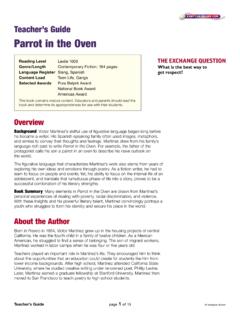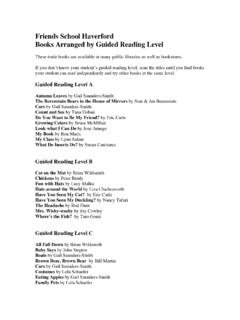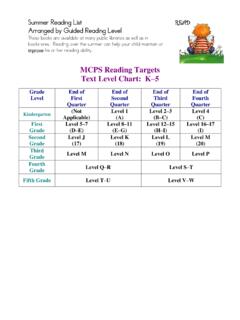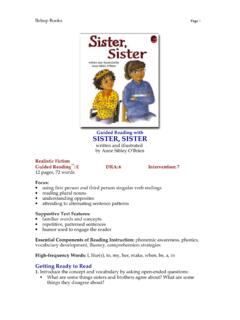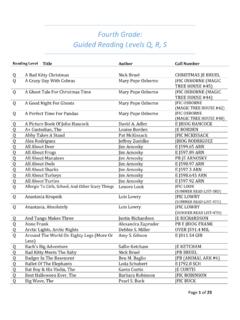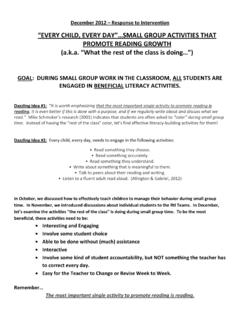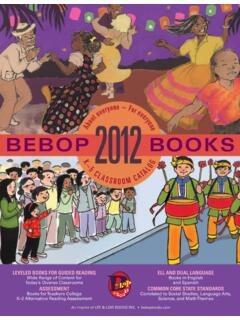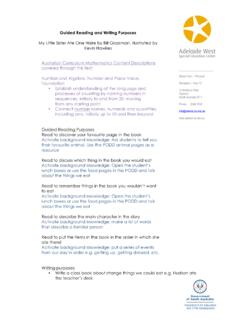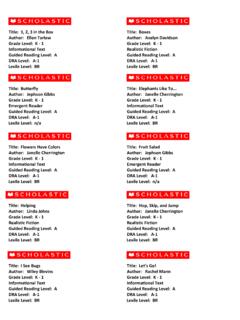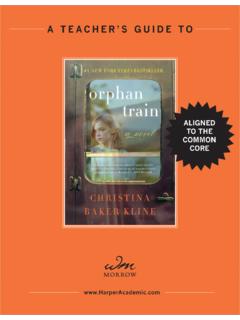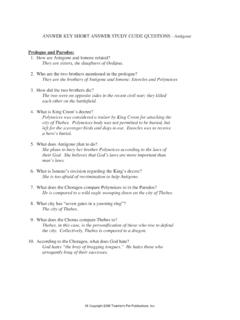Transcription of Teacher’s Guide Ties That Bind, Ties That Break
1 Teacher s Guide page 1 of 15 Hampton-BrownReading Level Lexile 830 Genre/LengthHistorical Fiction; 176 pagesLanguage RegisterNarrative, Figurative Language, CulturalContent LoadFoot Binding; Chinese HistorySelected AwardsCalifornia Young Reader MedalWashington State Governor s Writer s AwardALA Best Books ListTeacher s GuideTies that Bind, ties that BreakOverviewBackground ties that Bind, ties that Break is a fictional account of the cultural implications of foot binding in the early 1900s. At that time, foot binding was a clear indicator of class and status, and the lotus foot, at less than 3 inches in length, was the ideal sign of 1911, arranged marriages were still the norm for the middle and upper classes. Although ideas about foot binding were changing, having unbound feet was still an acceptable reason to call off an arranged marriage.
2 Girls who refused to have their feet bound were ostracized by their families and Summary ties that Bind, ties that Break tells the story of Ailin Tao, a girl who refuses to have her feet bound. In the Prologue, Ailin lives in California and works in a restaurant. After running into her ex-fianc , Ailin recalls her childhood and the events that led to this point in her refusing to have her feet bound, Ailin is exiled from her family. She works for an American family before moving with them to the United States. It is there that she finds love with a forward-thinking Chinese American the AuthorLensey Namioka was born in 1929, in Beijing, China, and moved to the United States when she was nine. As a writer, Namioka drew from her own experiences of moving to a new country and learning a new is the author of many books for children and young adults.
3 Having lived and traveled all over the world, she has also written travel books about Japan, where her husband is from, and China. Lensey Namioka has been writing for over thirty years, and she speaks frequently at schools and bookstores. She currently lives in Washington with her EXCHANGE QUESTIONIs it ever right to do the wrong thing? ties that Bind, ties that BreakTeacher s Guide page 2 of 15 Hampton-BrownStudent Journal, page 1 Name:Student JournalTies that Bind, ties that Breakby Lensey NamiokaReading ScheduleGroup members: _____Ties that Bind, ties that BreakStudent Journal Due Date Discussion Date IntroductionPages 2 4 Prologue and Chapters 1 2 Pages 5 6 Chapters 3 4 Pages 7 8 Chapters 5 7 Pages 9 10 Chapters 8 9 Pages 11 12 Chapters 10 11 and Epilogue Pages 13 14 The Exchange Assessment Is it ever right to do the wrong thing?
4 19/13/06 5:48:54 AMStudent Journal, page 2 ties that Bind, ties that BreakGetting StartedWhat If?Your school has decided that everyone should get a tattoo. Students will have their name and grades tattooed on their arms. The tattoo is permanent, but tattooed students will receive special treatment. If you are tattooed, you will not have to work as hard as other students want to be tattooed, but you do not. You do not want to be branded for life. Your friends and teachers are pressuring you to decide. You want to do the right thing, but the tattoo does not seem like a fair practice to you. Make notes about how this would affect you. Would you allow yourself to be tattooed? Why or why not? Would you encourage or discourage your friends from getting a tattoo? How would you feel about your school s new tattoo policy?
5 Connect to The Exchange Question Discuss how this situation could relate to The Exchange Question: Is it ever right to do the wrong thing? Summarize your 29/13/06 5:49:01 AMGetting StartedHave students read What If? on Student Journal, page 2 and discuss the scenario. Encourage students to describe the similarities and differences between the scenario and their lives and imagine how the situation would affect them. Have students write their responses to the three questions below the scenario and compare answers with a partner or the group. Have students discuss how the situation might relate to The Exchange question and then write a brief summary of their discussion in the Student the BookThere are several options for reading ties that Bind, ties that Break . They include: Whole Class Assign sections of the book and discussion dates using the planner on Student Journal, page 1.
6 After students read a section and respond to the corresponding Student Journal pages, have a class discussion. At the end of the book, the class meets for The Exchange. Small Groups Read the book Introduction with the group. Group members then read an agreed-upon number of pages, complete the corresponding Student Journal pages, and meet to discuss. When they finish the book, they meet again for The Exchange. Use the planner on Student Journal, page 1 to establish meeting times. Independently Students read the book on their own and then meet as a group for The Exchange. Use the planner on Student Journal, page 1 to establish the meeting time. guided reading Have students read Student Journal, page 2 and monitor their discussion of the What If? scenario. Read aloud the book Introduction to give students background on the book.
7 As students read, use the Before You Move On questions to Guide comprehension. Use the Look Ahead to set a focus for reading the next set of pages. At the end of each section, assign the appropriate Student Journal pages. Discuss the pages before starting the next section. Establish a date for The Exchange and record it on the that Bind, ties that BreakTeacher s Guide page 3 of 15 Hampton-BrownStudent Journal, page 3 ties that Bind, ties that BreakIntroductionRead the Introduction on pages 7 9 in ties that Bind, ties that Introduction will help you understand key concepts in the book. Knowing them will help you discuss and write about the Introduction includes information about a popular legend telling how foot binding began the negative physical effects of foot binding the theories of why women allowed their feet to be bound when the practice of foot binding endedAfter you read the Introduction, answer these questions to check your What is the popular legend about how foot binding began?
8 2. Why did Chinese men want wives with bound feet?3. How did foot binding physically affect women?A dancing girl bound her feet so that she could dance on her people think that men wanted wives who were helpless and couldn t run away. Others think it is because these women were considered special, since they could not were crippled and could not move around easily. They could not Journal, page 4 ties that Bind, ties that BreakIntroduction: Key ConceptsWord WebStudy the Word Web for society. What words does society make you think of? Write a sentence using the word Conceptsattractivebindpracticesocietysta tusOn a separate sheet of paper, create a similar Word Web for each of the Key Concept words. Write a sentence for each WebpeoplegrouppopulationcommunityKey 49/13/06 5:49:02 AMIntroductionHave students read the book Introduction.
9 Check their comprehension with the three follow-up questions on Student Journal, page 3. Introduction: Key Concepts Have students study the first Key Concept with the help of the graphic organizer on Student Journal, page 4. After studying the example, they should create similar graphic organizers to focus their understanding of the remaining Key that Bind, ties that BreakTeacher s Guide page 4 of 15 Hampton-BrownPages 16 39 Answers for Before You Move On Prologue and Chapters 1 2 PAGE 271. Setting Where does the Prologue take place? What year is it? The Prologue takes place in San Francisco in Inference Hanwei and Ailin receive different educations. What does this tell you about their society s values?It is not as important to educate 391. Character How does Big Uncle treat Ailin? What does this show about him?
10 Big Uncle is stern, angry, doesn t respect girls, and is Evidence and Conclusions Ailin s father does not want her feet to be bound. How can you tell?Father looks sad when Mother mentions it; he tries to delay Journal, page 5 ties that Bind, ties that BreakRespond to Prologue and Chapters 1 21. Personal Response Ailin s family thinks Ailin will be more beautiful if her feet are bound. How do people you know improve their appearance? Do you agree with these practices? Why or why not?2. Compare and Contrast How is Ailin like Second Sister? How is she different? Use the word attractive in your Simile A simile uses like or as to compare two things. Reread page 38. The author compares Second Sister s foot to a piece of bread. Why?4. Generate Questions Write a question about this section for someone else reading this book.
